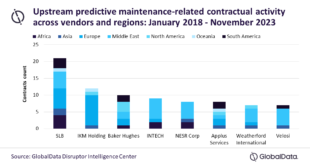Oil and gas (O&G) companies can no longer afford to ignore digitalisation, says GlobalData, which notes that any O&G company that doesn’t start to modernise now risks going under. The leading data and analytics company highlights Internet of Things (IoT) technologies such as digital twins have the potential to be the backbone of digitalisation in the energy sector.
Charlotte Newton, Thematic Analyst at GlobalData, comments: “On a rocky sea of fluctuating oil prices, expanding sources of supply, and increasing regulatory requirements, digitising operations and infrastructure can act as a life raft to energy companies in this age of uncertainty. Technologies such as IoT — the ability of everyday physical objects (such as fridges, watches or cars) to connect with other devices over the internet can help them mitigate the impact of these challenges.
“It may seem like a significant investment in the short term, at a time when most companies in the energy sector are stripping back capex and opex. However, in the long run, investment in IoT will pay dividends.”
According to GlobalData forecasts, the global Internet of Things (IoT) revenue in the energy sector is expected to reach $59 billion by 2025, up from $34 billion in 2019.
Newton continues: “Introducing IoT into daily operations makes them more efficient. Connected devices drive more sophisticated use of other technologies, namely artificial intelligence (AI), in the automation process. It creates a tech ecosystem that eases the difficulties of working in remote, dangerous conditions and working with aging, precarious assets through cross-functional collaboration.”
The energy sector is not always the quickest to adopt digitalisation. However, technologies such as digital twins – digital representations of physical assets, systems, or processes – have great potential in this sector.
Newton adds: “Technology like digital twins which simulate everyday scenarios can help companies make the process of designing rigs, highlighting health and safety risks, and identifying viable sources of oil and gas, easier and quicker. This is essential to an industry for which accidents, wasted resources and inefficient daily operations cost millions. Ultimately, oil and gas companies can’t afford to ignore IoT technology.”
 Engineer News Network The ultimate online news and information resource for today’s engineer
Engineer News Network The ultimate online news and information resource for today’s engineer


